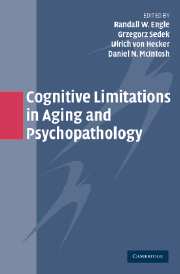Book contents
- Frontmatter
- Contents
- List of Contributors
- Preface
- Acknowledgments
- 1 Cognitive Limitations in Aging and Psychopathology: An Introduction and a Brief Tutorial to Research Methods
- SECTION I WORKING MEMORY AND COGNITIVE FUNCTIONS
- SECTION II AGING AND PSYCHOPATHOLOGY OF COGNITIVE CONTROL
- SECTION III ATTENTION, INHIBITION, AND REASONING PROCESSES
- 10 The Nature of Attentional Bias in Human Anxiety
- 11 Inhibition, Rumination, and Mood Regulation in Depression
- 12 Aging and Inhibitory Processes in Memory, Attentional, and Motor Tasks
- 13 Impairments of Memory and Reasoning in Patients with Neuropsychiatric Illness: Disruptions of Dynamic Cognitive Binding?
- 14 Generative Reasoning as Influenced by Depression, Aging, Stereotype Threat, and Prejudice
- Name Index
- Subject Index
- References
12 - Aging and Inhibitory Processes in Memory, Attentional, and Motor Tasks
Published online by Cambridge University Press: 20 May 2010
- Frontmatter
- Contents
- List of Contributors
- Preface
- Acknowledgments
- 1 Cognitive Limitations in Aging and Psychopathology: An Introduction and a Brief Tutorial to Research Methods
- SECTION I WORKING MEMORY AND COGNITIVE FUNCTIONS
- SECTION II AGING AND PSYCHOPATHOLOGY OF COGNITIVE CONTROL
- SECTION III ATTENTION, INHIBITION, AND REASONING PROCESSES
- 10 The Nature of Attentional Bias in Human Anxiety
- 11 Inhibition, Rumination, and Mood Regulation in Depression
- 12 Aging and Inhibitory Processes in Memory, Attentional, and Motor Tasks
- 13 Impairments of Memory and Reasoning in Patients with Neuropsychiatric Illness: Disruptions of Dynamic Cognitive Binding?
- 14 Generative Reasoning as Influenced by Depression, Aging, Stereotype Threat, and Prejudice
- Name Index
- Subject Index
- References
Summary
The past few years have seen an increasing focus on inhibitory processes in cognition (see Dempster, 1992; Dempster & Brainerd, 1995), especially in their impairment in certain patient populations (e.g., Beech, Powell, McWilliam, & Claridge, 1989; Cohen & Servan-Schreiber, 1992), in their development during childhood (e.g., Harnishfeger, 1995), and in their decline with normal aging (e.g., McDowd, Oseas-Kreger, & Filion, 1995). In this chapter, we briefly describe the inhibition deficit hypothesis of cognitive aging and discuss some logical and methodological issues that have complicated its investigation. We then present three aging studies across the different domains of short-term memory (Maylor & Henson, 2000), visual search (Watson & Maylor, 2002), and motor control (Schlaghecken & Maylor, 2005). In each case, it is argued that inhibitory processes are responsible for the effects of interest, namely, the Ranschburg effect (Crowder, 1968; Jahnke, 1969), the preview benefit in visual search (known as visual marking; Watson & Humphreys, 1997), and the negative compatibility effect (Eimer & Schlaghecken, 1998), respectively. What these three effects have in common is that, at some level, they all occur as a result of inhibitory processes that suppress responses to stimuli that are no longer relevant to current goals. The results show mixed support for the inhibition deficit hypothesis of aging, the current status of which is finally discussed in the light of these and other data.
Information
- Type
- Chapter
- Information
- Cognitive Limitations in Aging and Psychopathology , pp. 313 - 345Publisher: Cambridge University PressPrint publication year: 2005
References
Accessibility standard: Unknown
Why this information is here
This section outlines the accessibility features of this content - including support for screen readers, full keyboard navigation and high-contrast display options. This may not be relevant for you.Accessibility Information
- 5
- Cited by
